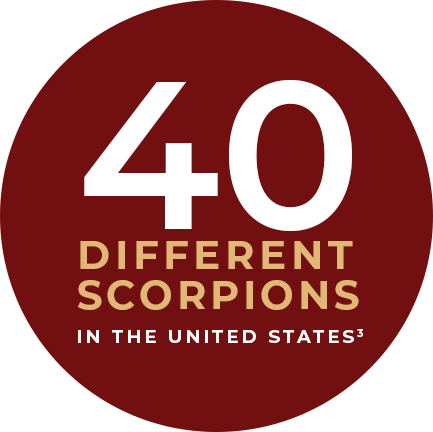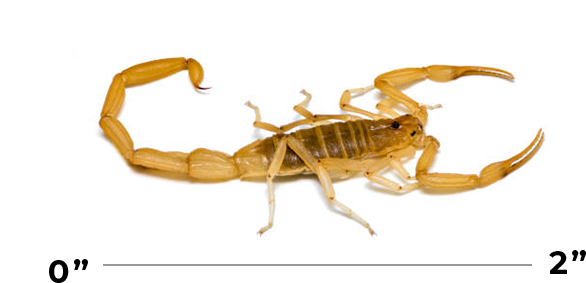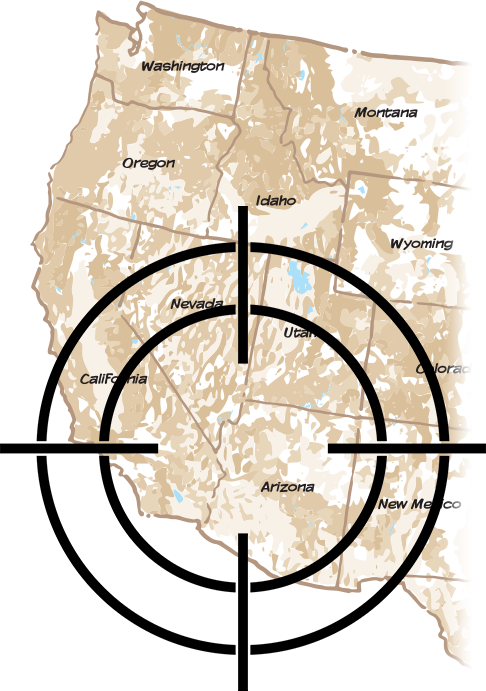SCORPION STINGS
Scorpions
It is estimated that there are as many as 1500 different species of scorpions worldwide.1 The United States is home to at least 40 species, found primarily in the southern and western states. Stings can cause local pain and swelling and do not usually warrant medical treatment.2
However, one species in the United States is regarded as medically significant: the Centruroides sculpturatus, better known as the bark scorpion.3


Bark Scorpion
Bark scorpions can be distinguished from other less dangerous species by their more slender tail segments and pincers, and by locating a tubercle (small bump) at the base of their stingers. Scorpions inject venom from a stinger on their tail and not by biting their victims. These scorpions only grow to about 2 inches at maturity. They have 4 pairs of legs and a pair of pedipalps, or front limbs with pincers, which are used for restraining prey, as well as for defense.4
Where can you find a bark scorpion?

Most people are stung by scorpions inside or around their own homes.6 Scorpions inject venom from a stinger on their tail and not by biting their victims.4 Undisturbed scorpions will spend the daylight hours in dark cracks and crevices, in woodpiles, or under debris on the ground.4
Most stings occur at night when scorpions venture into human habitats in search of insect prey. Small cracks and breeches in homes, especially around doors and windows, provide easy entry for these comparatively small scorpions.4 Once indoors, they seek out moist and cool areas, such as sink areas, bathtubs, and laundry areas.7,8
With flat and elongated bodies, bark scorpions are avid climbers that go up vertical surfaces in our homes, and also across ceilings. While practicing what is called “negative geotaxis” or hanging upside down, scorpions can drop from the ceiling and land in some unsuspected locations,8 like a fruit bowl or in an infant’s crib. Failing to turn on lights before entering a dark room can increase our chances of encountering a scorpion, and thus of getting stung.
- Mills EJ, Ford N. Research into scorpion stings. BMJ. 2011;342:c7369.
- Mount Sinai. Scorpions. Accessed January 23, 2024. https://www.mountsinai.org/health-library/poison/scorpions.
- Kang AM, Brooks DE. Nationwide Scorpion Exposures Reported to US Poison Control Centers from 2005 to 2015. J Med Toxicol. 2017;13(2):158-165.
- Natwick ET. Scorpions. Pest Notes. 2011(74110):1-4.
- Simon, RB. Bark scorpion envenomation. Nursing Critical Care. 2016;11(2):44-47.
- McIntyre NE. Influences of urban land use on the frequency of scorpion stings in the Phoenix, Arizona, metropolitan area. Landscape and Urban Planning. 1999;45(1):47-55.
- Terminel E, Ferguson K, Tubac V. Toxic species of the Sonoran Desert: Perception vs reality. Sonoran Desert Discovery, University of Arizona. 2010.
- Likes K, Banner W Jr, Chavez M. Centruroides exilicauda envenomation in Arizona. West J Med. 1984;141(5):634-637.
INDICATION
ANASCORP® [centruroides (scorpion) immune F(ab')2 (equine) injection] is an equine-derived antivenom indicated for treatment of patients with clinical signs of scorpion envenomation.
IMPORTANT SAFETY INFORMATION
INDICATION
ANASCORP® [centruroides (scorpion) immune F(ab')2 (equine) injection] is an equine-derived antivenom indicated for treatment of patients with clinical signs of scorpion envenomation.
IMPORTANT SAFETY INFORMATION
CONTRAINDICATIONS
None.
WARNINGS AND PRECAUTIONS
Hypersensitivity Reactions
Severe hypersensitivity reactions, including anaphylaxis, may occur with ANASCORP. Close patient monitoring for hypersensitivity reactions and readiness with intravenous therapy using epinephrine, corticosteroids, and diphenhydramine hydrochloride is recommended during the infusion of ANASCORP. If an anaphylactic reaction occurs during the infusion, terminate administration at once and administer appropriate emergency medical care. Patients with known allergies to horse protein are particularly at risk for an anaphylactic reaction. Patients who have had previous therapy with ANASCORP or another equine antivenom/antitoxin may have become sensitized to equine protein and be at risk for a severe hypersensitivity reaction.
Delayed Allergic Reactions
(Serum Sickness) Monitor patients with follow-up visit(s) for signs and symptoms of delayed allergic reactions or serum sickness (e.g., rash, fever, myalgia, arthralgia), and treat appropriately if necessary. Eight out of 1,534 (0.5%) patients in the clinical trials exhibited symptoms suggestive of serum sickness.
Transmissible Infectious
Agents ANASCORP is made from equine (horse) plasma, it may therefore carry a risk of transmitting infectious agents, e.g., viruses.
Reaction to Cresol
Trace amounts of cresol from the manufacturing process are contained in ANASCORP. Localized reactions and generalized myalgias have been reported with the use of cresol as an injectable excipient.
ADVERSE REACTIONS
The most common adverse reactions observed in ? 2% of patients in the clinical studies for ANASCORP were: vomiting, pyrexia, rash, nausea and pruritus.
See Full Prescribing Information.
To report SUSPECTED ADVERSE REACTIONS, contact Rare Disease Therapeutics, Inc., at 1-844-472-7389 or by email at safety@raretx.com, or FDA at 1-800-FDA-1088 or www.fda.gov/medwatch.
ANS-ISIF-001
ANASCORP® [centruroides (scorpion) immune F(ab')2 (equine) injection] is an equine-derived antivenom indicated for treatment of patients with clinical signs of scorpion envenomation.
IMPORTANT SAFETY INFORMATION
CONTRAINDICATIONS
None.
WARNINGS AND PRECAUTIONS
Hypersensitivity Reactions
Severe hypersensitivity reactions, including anaphylaxis, may occur with ANASCORP. Close patient monitoring for hypersensitivity reactions and readiness with intravenous therapy using epinephrine, corticosteroids, and diphenhydramine hydrochloride is recommended during the infusion of ANASCORP. If an anaphylactic reaction occurs during the infusion, terminate administration at once and administer appropriate emergency medical care.
Patients with known allergies to horse protein are particularly at risk for an anaphylactic reaction. Patients who have had previous therapy with ANASCORP or another equine antivenom/antitoxin may have become sensitized to equine protein and be at risk for a severe hypersensitivity reaction.
Delayed Allergic Reactions (Serum Sickness)
Monitor patients with follow-up visit(s) for signs and symptoms of delayed allergic reactions or serum sickness (e.g., rash, fever, myalgia, arthralgia), and treat appropriately if necessary. Eight out of 1,534 (0.5%) patients in the clinical trials exhibited symptoms suggestive of serum sickness.
Transmissible Infectious Agents
ANASCORP is made from equine (horse) plasma, it may therefore carry a risk of transmitting infectious agents, e.g., viruses.
Reaction to Cresol
Trace amounts of cresol from the manufacturing process are contained in ANASCORP. Localized reactions and generalized myalgias have been reported with the use of cresol as an injectable excipient.
ADVERSE REACTIONS
The most common adverse reactions observed in ≥ 2% of patients in the clinical studies for ANASCORP were: vomiting, pyrexia, rash, nausea and pruritus.
Please see complete Prescribing Information.
To report SUSPECTED ADVERSE REACTIONS, contact Rare Disease Therapeutics, Inc., at 1-844-472-7389 or by email at safety@raretx.com, or contact FDA at 1-800-FDA-1088 or www.fda.gov/medwatch.
ANS-ISIF-001

2550 Meridian Blvd. Suite 150
Franklin, TN 37067
To order ANASCORP, call:
1-844-4RareTx (1-844-472-7389)
ANASCORP is exclusively distributed by:
AnovoRx www.anovorx.com
![ANASCORP® [centruroides (scorpion) immune F(ab')? (equine) injection]](https://www.anascorp-us.com/wp-content/uploads/2024/05/AnascorpLogo_color-tall.png)